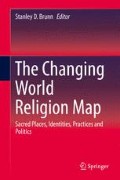Abstract
Martin Heidegger characterized the modern world as the “age of the world picture,” an era when the world became conquered as a picture or representation set fully and clearly before our gaze. In the 1960s, the first images of the Earth from space delivered a glimpse of a world picture that was global and ecological, but also suggested humanity’s domination both of the earth (today) and of outer space (tomorrow). Fifty years later, we have not colonized other planets, but we might speak instead of an age of the world motion picture, an era when our colonization extends to imaginary planets, like the Pandora of the blockbuster film Avatar (2009) and where we see our world and ourselves in turbulent and uncontrollable motion on screens around the globe. The moving image has been with us a little over a century and in that time the world has arguably come to move faster and faster all around us. For Gilles Deleuze it was cinema that provided the greatest resource for reviving our lost “belief in this world.” This chapter asks how cinema is faring today, on the cusp of the digital era, in supporting “belief in this world” and in the universe that sustains it. I examine five films made since 1968. The year in which we received the first images of the Earth from space: 2001, A Space Odyssey (1968), Solaris (1973), Contact (1997), The Tree of Life (2011) and Melancholia (2011). Drawing on the semiotics of C. S. Pierce, I examine how images of the Earth in space have “moved” their viewers and how their use in these films facilitates new forms of global identity built on new emotional and spiritual geographies.
Access this chapter
Tax calculation will be finalised at checkout
Purchases are for personal use only
References
2001, A Space Odyssey. (1968). Stanley Kubrick, dir. U.S.
Burnett, R. (2005). How images think. Cambridge: MIT Press.
Chaikin, A. (2009). Live from the moon: The social impact of Apollo. In S. J. Dick & R. D. Launius (Eds.), Societal impact of spaceflight (pp. 53–66). Washington, DC: NASA Office of External Relations, History Division.
Contact. (1997). Robert Zemeckis, dir. U.S.
Cosgrove, D. (1994). Contested global visions: One-world, whole-earth, and the Apollo space photographs. Annals of the Association of American Geographers, 84(2), 270–294.
Deleuze, G. (2005). Cinema 2: The time-image (trans: Tomlinson, H. & Galeta, R.). London: Continuum.
Deleuze, G., & Guattari, F. (1994). What is philosophy? (trans: Tomlinson, H. & Burchell, G.). New York: Columbia University Press.
Garb, Y. J. (1985, March). The use and misuse of the whole earth image. Whole Earth Review, pp. 18–25.
Heidegger, M. (1977). The age of the world picture. In W. Lovitt (Ed.), The question concerning technology and other essays (pp. 115–154). New York: Harper & Row.
Helmreich, S. (2011). From spaceship earth to Google ocean: Planetary icons, indexes, and infrastructures. Social Research, 78(4), 1211–1242.
Ivakhiv, A. J. (2013). Ecologies of the moving image: Cinema, affect, nature. Waterloo: Wilfrid Laurier University Press.
Jacobs, R. (2011). Whole earth or no earth: The origin of the whole earth icon in the ashes of Hiroshima and Nagasaki. The Asia-Pacific Journal, 9. 13. 5, March 28, 2011. www.japanfocus.org/-Robert-Jacobs/3505. Accessed 5 Sept 2012.
Jasanoff, S. (2001). Image and imagination: The formation of global environmental consciousness. In C. A. Miller & P. Edwards (Eds.), Changing the atmosphere: Expert knowledge and environmental governance (pp. 309–337). Cambridge: MIT Press.
Krämer, P. (2010). 2001. London: British Film Institute.
Lazier, B. (2011). Earthrise; or, the globalization of the world picture. The American Historical Review, 116(3), 602–630.
Melancholia. (2011). Lars Von Trier, dir. Denmark/Sweden/France/Germany.
Peirce, C. S. (1934). Collected papers (Vol. 2). Cambridge: Harvard University Press.
Reinert, A. (2011, April 12). The blue marble shot: Our first complete photograph of earth. Atlantic, pp. 24–25. www.theatlantic.com/technology/archive/2011/04/the-blue-marble-shot-our-first-complete-photograph-of-earth/237167/. Accessed 21 Aug 2012.
Solaris. (1973). Andrei Tarkovsky, dir. USSR.
The Tree of Life. (2011). Terrence Malick, dir. U.S.
Vishnevetsky, I. (2011, May 26). ‘The tree of life’: A Malickiad. Notebook. http://mubi.com/notebook/posts/the-tree-of-life-a-malickiad. Accessed 15 Oct 2011.
Žižek, S. (2000). The ting from inner space. In R. Salecl (Ed.), Sexuation (pp. 248–250). Durham/London: Duke University Press.
Author information
Authors and Affiliations
Corresponding author
Editor information
Editors and Affiliations
Rights and permissions
Copyright information
© 2015 Springer Science+Business Media Dordrecht
About this chapter
Cite this chapter
Ivakhiv, A. (2015). The Age of the World Motion Picture: Cosmic Visions in the Post-Earthrise Era. In: Brunn, S. (eds) The Changing World Religion Map. Springer, Dordrecht. https://doi.org/10.1007/978-94-017-9376-6_6
Download citation
DOI: https://doi.org/10.1007/978-94-017-9376-6_6
Published:
Publisher Name: Springer, Dordrecht
Print ISBN: 978-94-017-9375-9
Online ISBN: 978-94-017-9376-6
eBook Packages: Humanities, Social Sciences and LawPhilosophy and Religion (R0)

